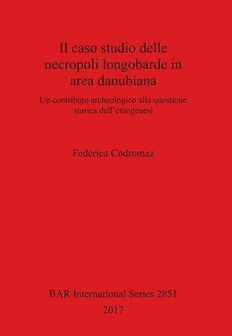
Il caso studio delle necropoli longobarde in area danubiana: Un contributo archeologico alla questione storica dell'etnogenesi PDF
157 Pages·2017·23.548 MB·Italian
Most books are stored in the elastic cloud where traffic is expensive. For this reason, we have a limit on daily download.
Preview Il caso studio delle necropoli longobarde in area danubiana: Un contributo archeologico alla questione storica dell'etnogenesi
Description:
Questo libro, basato sulla tesi dottorale dell'autrice, si focalizza sulle tradizioni funerarie e sulla società longobarda nell'ultima fase della migrazione. Le numerose teorie riguardanti identità ed etnogenesi, nate e sviluppatesi in ambito storico, hanno trovato impiego in campo archeologico: è in quest'ottica che la documentazione funeraria ha un carattere privilegiato, perché l'evidenza delle necropoli è la più ricca e la meglio conservata per buona parte dell'età delle migrazioni. L'analisi dei contesti funerari di 16 necropoli austriache ed ungheresi di cultura Longobarda ha fornito interessanti risultati riguardo la cultura e la società che ha composto quei corredi. L'approccio impiegato ha permesso di individuare numerosi elementi, dai quali sembra possibile trarre alcune valutazioni delle caratteristiche sociali, cultuali e culturali dei Longobardi in Pannonia, permettendo in questo modo di definire alcune caratteristiche della loro etnogenesi. This book, based on the author's doctoral thesis, focuses on the funerary customs and the society of the Langobards in the last phase of the migration period. Several theories about identity and ethnicity in the Middle Ages, developed in the field of history, have been used to interpret the archaeological records; from this perspective the funerary evidence holds a privileged position, because necropolises provide the richest and the best preserved evidence for the greater part of the age of migrations. Analysis of the grave goods of 16 necropolises of Austria and Hungary that display the material culture of the Langobard people has yielded interesting results relating to the funerary culture and the society that created these arrangements of grave goods. This analysis has permitted the identification of various data that grant an understanding of the construction and the development of the cultural and social identity of the Langobards during the last phase of their migration.
See more
The list of books you might like
Most books are stored in the elastic cloud where traffic is expensive. For this reason, we have a limit on daily download.
